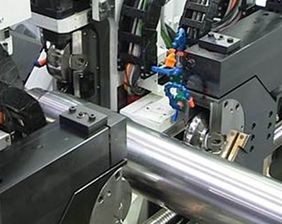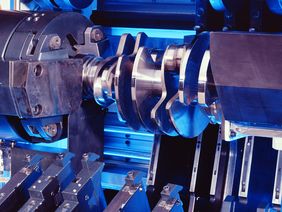Rolling prolongs lifespan
Mechanical surface hardening processes are firmly established in many sectors of engineering. For example, crankshafts for car engines are "deep rolled" in one of the final production processes in order to significantly prolong their lifespan. Deep rolling provides a simple method of slowing down or even preventing crack growth on defects.
During the process, a powerful work roller is applied to the rotating crankshaft, producing an extremely smooth surface with high fatigue strength. This enhanced fatigue strength can be attributed in part to the smooth surface but is mainly due to the residual compressive stress caused by the plastic deformation of the material layers close to the surface. Deep rolling therefore represents a simple and cost-effective process for improving the damage tolerance of components by inducing residual compressive stress.
Deep rolled crankshafts
How stable are these residual stresses in service, though? The Materials Center Leoben, Hegenscheidt-MFD GmbH and Siemens AG Österreich set out to find an answer to this question. Particular importance was attached to selecting a simple approach which was suitable for both initial rough estimates and for the comparison of different deep rolling tools. To achieve this, wheelset axles were deep rolled with different tools, followed by an evaluation of the residual stress curves. Laboratory samples with smaller dimensions were also deep rolled and subjected to a long-term test at various load levels and different load cycles. The remaining residual stresses were then measured.
The experiments showed that the residual stresses and the associated fatigue strength were reduced only at very high loads which far exceeded normal service loads. In order to make practical use of this knowledge, the project team developed a rule of thumb based on calculations and backed up by test results. This mathematical model makes it possible to predict the stability of the residual stresses induced by deep rolling during fatigue loading. So there is no need to worry about deep rolled crankshafts in cars because the residual stresses applied keep their promises.
Impact
One significant outcome of this collaborative project has been the creation of an easy-to-use model for production companies. This model makes it possible to make a quick and reliable estimate of whether and to what extent the residual stresses in the material will change in service and what effect this will have on component fatigue strength. This will also facilitate the provision of appropriate safety verification.




















